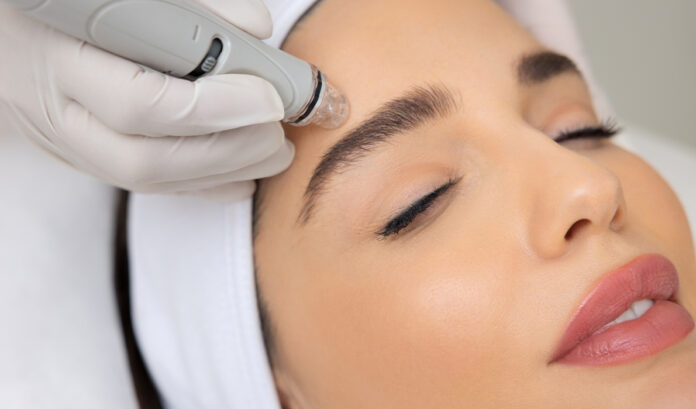When it comes to maintaining radiant and healthy skin, innovative treatments like Hydrafacial have taken the spotlight. Known for its ability to cleanse, exfoliate, extract, and hydrate the skin in one session, Hydrafacial is a go-to for many skincare enthusiasts. This non-invasive procedure combines vortex technology with nourishing serums to rejuvenate the skin without downtime. Hydrafacial in Dubai has become increasingly popular due to the region’s unique climate and growing demand for advanced skincare solutions. Whether you’re battling dryness from air conditioning or excess oil due to heat and humidity, Hydrafacial caters to a wide variety of skin types and concerns.
Understanding the Hydrafacial Process
Before diving into which skin types benefit most, it’s essential to understand how the treatment works. The Hydrafacial procedure includes:
- Cleansing and Exfoliation: Removes dead skin cells and sebum.
- Acid Peel: A gentle chemical exfoliation that loosens debris from pores.
- Extraction: Painless suction removes blackheads and impurities.
- Hydration: Antioxidants, peptides, and hyaluronic acid are infused into the skin.
This four-step process not only clears out pores but also deeply nourishes the skin, leaving it glowing and refreshed.
Who Can Benefit From Hydrafacial?
The universal appeal of Hydrafacial lies in its versatility. Unlike some treatments that are limited by skin sensitivity or tone, Hydrafacial is safe and effective for nearly all skin types. However, some individuals see especially remarkable results.
Dry and Dehydrated Skin
One of the most immediate benefits of Hydrafacial is hydration. For those suffering from dry or flaky skin, the infusion of hyaluronic acid and moisturizing serums helps restore softness and elasticity. The treatment not only replenishes moisture but also strengthens the skin’s barrier to prevent future dehydration.
Oily and Acne-Prone Skin
Hydrafacial is a game-changer for oily or acne-prone skin. The deep cleansing and painless extraction process help remove excess sebum and clear clogged pores. Additionally, the gentle exfoliation reduces the appearance of acne scars and prevents new breakouts, making it an excellent choice for teens and adults alike.
Sensitive Skin
Many treatments can irritate sensitive skin, but Hydrafacial is known for its gentle yet effective approach. Its non-abrasive technology ensures minimal inflammation, and the serums can be customized to soothe redness and irritation. This makes it an ideal option for individuals with rosacea, mild dermatitis, or general skin sensitivity.
Aging Skin
Hydrafacial can also be tailored to target signs of aging. With serums rich in antioxidants and peptides, the treatment helps improve firmness, reduce fine lines, and boost collagen production. Regular sessions can visibly rejuvenate mature skin, giving it a firmer, more youthful appearance.
Combination Skin
For those who struggle with both dry patches and oily zones, Hydrafacial offers a balanced solution. The treatment is easily customizable, allowing aestheticians to address specific needs in different areas of the face. This personalized approach results in evenly nourished and revitalized skin.
Skin Concerns Addressed by Hydrafacial
Hydrafacial is not just about skin type—it also targets a variety of skin concerns that can affect individuals differently. Here’s a breakdown of common skin issues and how Hydrafacial helps:
| Skin Concern | Hydrafacial Benefits |
|---|---|
| Enlarged Pores | Deep cleansing and suction reduce the appearance of pores. |
| Hyperpigmentation | Gentle exfoliation and brightening serums improve skin tone. |
| Fine Lines & Wrinkles | Peptides and antioxidants help to firm and smooth the skin. |
| Blackheads & Congestion | Painless extractions clear clogged pores. |
| Dullness | Exfoliation and hydration bring back a radiant glow. |
Tailoring Hydrafacial for Different Skin Tones
One of the standout qualities of Hydrafacial is its adaptability to all skin tones. From fair to deep complexions, the treatment provides visible improvements without the risk of post-inflammatory hyperpigmentation—an issue more common in darker skin types with some procedures.
| Skin Tone | Hydrafacial Suitability |
|---|---|
| Fair | Helps combat dryness and sun sensitivity. |
| Medium | Targets pigmentation and oiliness effectively. |
| Olive | Reduces acne scars and enhances radiance. |
| Deep | Safely treats hyperpigmentation and texture without irritation or discoloration. |
Who Should Avoid Hydrafacial?
Although Hydrafacial is suitable for most, there are a few exceptions:
- Individuals with active rashes or sunburn.
- Those with severe rosacea flares.
- Anyone with certain medical skin conditions or infections should consult a dermatologist first.
It’s always best to have a skin evaluation before undergoing the treatment to ensure it’s the right fit for your specific needs.
Benefits of Regular Hydrafacial Treatments
Consistency is key when it comes to skincare. Scheduling Hydrafacial sessions every 4–6 weeks can lead to cumulative benefits such as:
- Improved skin texture
- Reduced acne frequency
- Enhanced skin hydration
- Even skin tone
- Long-term anti-aging effects
Regular maintenance allows your skin to stay ahead of concerns rather than just reacting to them.
FAQs
1. Is Hydrafacial safe for all skin types?
Yes, Hydrafacial is generally safe for all skin types, including sensitive, oily, and dry skin. It is non-invasive and customizable, making it suitable for a wide range of skin conditions and tones.
2. Can Hydrafacial treat acne?
Absolutely. Hydrafacial helps by extracting clogged pores, reducing oil buildup, and infusing the skin with antibacterial and calming serums, making it highly beneficial for acne-prone individuals.
3. How long does a Hydrafacial treatment take?
Typically, a Hydrafacial session takes about 30 to 45 minutes. It’s often referred to as a “lunchtime facial” because of its quick and convenient application without downtime.
4. What should I expect after my first Hydrafacial?
You can expect instantly smoother, more hydrated, and glowing skin. There’s no recovery time, and makeup can be applied immediately after if desired.
5. How often should I get a Hydrafacial?
For best results, it’s recommended to undergo Hydrafacial treatments every 4 to 6 weeks, depending on your skin’s needs and goals.
Final Thoughts
Hydrafacial offers a flexible, effective skincare solution suitable for virtually all skin types and tones. Whether you’re tackling dryness, oiliness, sensitivity, or signs of aging, this treatment can be personalized to your skin’s unique needs. With consistent care and professional guidance, Hydrafacial can transform your skincare routine and enhance your skin’s health and appearance.































